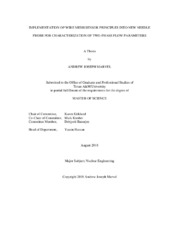Implementation of Wire Mesh Sensor Principles into New Needle Probe for Characterization of Two-Phase Flow Parameters
Abstract
The design and operation of Light Water Reactors requires an in-depth knowledge of the various two-phase flow phenomena that are present in both normal operating conditions and those possible in accident scenarios. This has led to a very large amount of interest in this field as well as the development of complex codes that seek to model this behavior. To verify that the models used in simulation efforts are close enough to reality to safely use, an accurate experimental database covering expected reactor conditions is needed.
A new full-scale heated rod bundle facility was designed to capture high fidelity void fraction data. There are several techniques in the literature for measuring void fraction, each with its own advantages and weaknesses. One such technique, the wire mesh sensor, which can measure the local instantaneous void fraction over an entire cross section of interest at very high sampling rates, will be employed in the full-scale facility. Using this sensor in a rod bundle flow channel introduces complications not present when employing the sensor in a flow channel with no obstructions. Physical obstructions in the flow channel limit the number of measurement points, as the wires must be routed through the channel. With fewer convenient measurement locations, the 2-D picture of the void fraction in rod bundles has been less attainable than in other applications.
To solve this problem, a new type of needle probe sensor was designed and tested in this thesis, working on the same operating principles of the wire mesh sensor.
The needle probe can be moved anywhere in the 2-D plane of interest and increases the number of measurement sites in areas of interest despite the rod bundle geometry presenting unique challenges to this type of sensor.
To verify the operation of the needle probe, a prototype facility was designed and built that would allow simpler, more rapid testing of the needle probe than in the full-scale rod bundle flow channel. The prototype facility operates with air-water mixtures at atmospheric pressures, enabling needle probe proof-of-concept in a well-defined test environment. The needle probe’s functionality was demonstrated and compared to that of a wire mesh sensor built for the prototype facility. An uncertainty analysis of the needle probe showed that the sensor currently can measure the void fraction with an uncertainty of 11%, which is very comparable to that the first wire mesh sensors implemented in the late 1990’s.
Citation
Marvel, Andrew Joseph (2018). Implementation of Wire Mesh Sensor Principles into New Needle Probe for Characterization of Two-Phase Flow Parameters. Master's thesis, Texas A & M University. Available electronically from https : / /hdl .handle .net /1969 .1 /173888.


